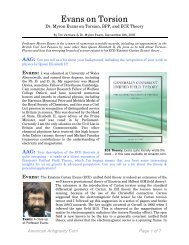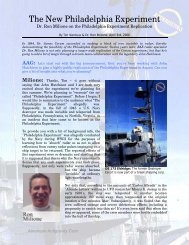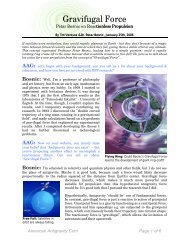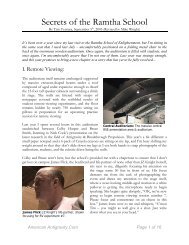Engineering Wormholes - American Antigravity
Engineering Wormholes - American Antigravity
Engineering Wormholes - American Antigravity
Create successful ePaper yourself
Turn your PDF publications into a flip-book with our unique Google optimized e-Paper software.
<strong>American</strong> <strong>Antigravity</strong>.Com Page 1 of 8
By Tim Ventura, December 3rd, 2006<br />
<strong>Wormholes</strong> offer an opportunity to connect distant points in space, thereby bypassing the need for FTL<br />
propulsion – but they come at a cost, consuming vast amounts of energy to stabilize the wormhole’s<br />
throat. Assuming that anticipated advances in science give us the ability to generate and control<br />
wormholes, this article explores the likely path of development for this speculative technology,<br />
presenting avenues for major advances from communications to even interstellar colonization…<br />
Realistically speaking, the concepts related to stabilizing and expanding the throat of a<br />
quantum-wormhole using exotic matter have only been given serious consideration for the last<br />
couple of decades, and it wouldn’t be at all surprising if a breakthrough occurs to allow point-topoint<br />
wormhole connections a reality within the<br />
next few years. When this is achieved, it will then<br />
lead to a number of questions relating to how<br />
wormholes can be engineered for practical<br />
applications, as well as leading to questions about<br />
what those applications might be, and how this<br />
technology might evolve over time as it matures…<br />
Arthur C. Clarke addressed this topic in his<br />
science-fiction classic, "The Light of Other Days".<br />
The primary focus of his novel was to examine<br />
the social impact of exactly what might happen if<br />
a "wormhole-camera" was developed that could<br />
ostensibly provide an unrestricted real-time view<br />
of any location in space ...when published, his<br />
focus was to offer an extreme case-example<br />
focusing on the limits of privacy and what it<br />
means in an increasingly sophisticated society.<br />
The mechanism for this was a stabilized<br />
quantum-wormhole measuring only an atom's<br />
width across, connected to a processing unit to<br />
enhance the few photons’ worth of light that it<br />
captured into a visible image from the<br />
wormhole's endpoint.<br />
Quantum Wormhole: Near-term nanoscale<br />
connections between distant points in space?<br />
Like Clarke, I imagine that this technology would start small, mostly due to the powerlimitations<br />
involved with stabilizing a quantum-wormhole. The initial application would most<br />
likely be point-to-point communications, with both ends of the wormhole connected to highsensitivity<br />
transceivers to overcome the inherent limitations in amplitude associated with<br />
passing only a few photons through the hole's tiny aperture.<br />
Using today's technology, a radio or data signal could be transmitted quite easily, and a visual<br />
signal like the type that Clarke described would be only marginally more technically challenging.<br />
<strong>American</strong> <strong>Antigravity</strong>.Com Page 2 of 8
First-Generation<br />
The initial device has two primary applications - the first of which is the equivalent of a "Faster<br />
than Light" signal that should prove useful for real-time communications and control for<br />
satellites, and the second is an uninterruptible,<br />
completely-secure means for transmitting sensitive<br />
data (for instance, as an alternative to today's lowbandwidth<br />
RF-based submarine communications).<br />
It is presumed that any signal capable of being sent<br />
using conventional broadcast-radio or fiber-optic<br />
technology could also be sent through a wormhole,<br />
which allows a high-level of integration into today's<br />
existing communications technology base.<br />
There is one variable relating to point-to-point<br />
wormhole communications that Clarke did not<br />
address, which plays a critical role in how this<br />
technology might be deployed. Each set of<br />
Point-To-Point: <strong>Wormholes</strong> might allow<br />
FTL signals to take a shortcut through space.<br />
wormholes form the endpoints of a<br />
communications bridge, meaning that for our<br />
purposes at least 1 signaling link can be established. However, it has not been determined<br />
whether multiple units may interfere with each other's operation. It is assumed for the sake of<br />
argument that each wormhole is an entity unto itself, and that signals cannot mix in the<br />
"subspace" or extra-dimensional region between wormhole points. (This is consistent with<br />
known physics, which assumes that the neck of a wormhole is normal space, albeit warped).<br />
The second variable relating to point-to-point communications is far more critical: the<br />
minimum physical size of the communications device required at each of the wormhole<br />
endpoints. If the device is the size of a typical personal-computer, then communications is<br />
possible, but will resemble today's internet proxy-server - functioning as a communications<br />
gateway for multiple channels between two points. If the device is smaller, however, such as a<br />
crystalline nano-lattice developed using near-term vapor-deposition technologies, then the<br />
wormhole communications device can then be highly integrated into conventional electronics<br />
architectures, and may be used ubiquitously for point-to-point communications within<br />
computers, consumer-electronics, and all manner of common applications normally served by<br />
copper-wire or fiber-optic cabling. Simply put, this defining difference serves to determine<br />
whether wormhole communications are used between devices or within devices - a distinction<br />
with serious implications for future technology development.<br />
Communications: First-generation apps<br />
might resemble a fiber-optic communications<br />
It should be noted that traditional marketeconomic<br />
forces will inevitably drive R&D efforts to<br />
refine the size & production-cost for any type of<br />
wormhole communications system over time, so a<br />
system that begins at the size of a personal<br />
computer may in fact end up being constructed on<br />
the nanoscale, much like the similar progression of<br />
transistor size within modern commercial CPU's.<br />
Regardless of the actual cost for first-generation<br />
devices, market forces also typically drive radically<br />
new technologies to higher-price points, making it<br />
likely that a first-generation system will be reserved<br />
for high-end communications needs, typically<br />
found in military or space-applications.<br />
<strong>American</strong> <strong>Antigravity</strong>.Com Page 3 of 8
Second-Generation<br />
The obvious applications constraints associated with point-to-point communications via two<br />
bound-wormholes will lead to an evolution of the technology to allow transmission through an<br />
asymmetrical, or "unbound" wormhole communications system. This system will be defined as<br />
having 1 end of the wormhole generated and bound to a communications transceiver, and the<br />
other end being a free-floating quantum-wormhole in 3-space. The term unbound is appropriate<br />
despite one end being bound to a transceiver, given the ability for this wormhole to<br />
instantaneously be repositioned at any point in space - without the requirement for a local<br />
stabilizing mechanism - provides a tremendous degree of additional application flexibility.<br />
A second-generation wormhole communications device will exhibit not only the ability to<br />
transmit and receive conventional data signals from any nearby communications devices in a<br />
manner identical to the first-generation technology, but will also by able to "eavesdrop" in the<br />
manner described by Clarke. It may be able to<br />
directly receive small bundles of photons as a form<br />
of "remote-camera", thus allowing the user to<br />
reposition a "virtual wormcam" to any point in<br />
space to capture a picture of nearby objects. Clarke<br />
also envisioned that the wormhole could receive<br />
audio-signals by tracking the vibrational movement<br />
of nearby atoms in response to sound waves.<br />
Clarke used examples of this technology to show<br />
the immediately destructive influence of ubiquitous<br />
information access on contemporary society: his<br />
vision demonstrated a form of "surveillance<br />
society" with a twist: everyone in the society is<br />
conducting surveillance on everybody else, and<br />
nobody is aware at any given time who may be<br />
watching them. This leads to such a wide range of<br />
immediate social changes that I'm literally unable<br />
to list them all here. Clarke's vision also suggested<br />
an immediate revolution in physics and astronomy,<br />
given our new ability to view both the very small<br />
and the very large from viewpoints never before<br />
imagined. For instance, Clarke suggested mapping<br />
the surface of other planets using automated<br />
scanning-technology, capable of taking in the<br />
surface terrain of an entire planet within a matter<br />
of hours.<br />
2.5-Generation<br />
Implications: An idea examined by Arthur<br />
C. Clarke in “The Light of Other Days”.<br />
While highly speculative, Clarke also suggested that given the quantum-nature of the wormhole<br />
communications device, it might be capable of viewing different points in time as well as space.<br />
"The Light of Other Days" constrained this idea by suggesting that it only functioned to view<br />
events that have already occurred, thus preventing paradox from occurring. Even so, this<br />
capability offers an entirely new range of social implications - exemplified by Clarke's<br />
speculation that most politicians would be removed from office for a variety of scandals very<br />
shortly after this device is introduced. Clarke also suggested that this device would revolutionize<br />
history in the same manner that the second-generation device revolutionizes cosmology and<br />
physics.<br />
<strong>American</strong> <strong>Antigravity</strong>.Com Page 4 of 8
Third Generation<br />
Clarke's vision ends with the speculative notion that it might be possible to pass matter through<br />
a wormhole - obviously in very small quantities, given the tiny aperature and powerrequirements<br />
of the device. Clarke's final thought in<br />
"The Light of Other Days" revolves around the<br />
notion of importing a stream of matter from the<br />
center of the sun to create a form of pseudo-stable<br />
fusion on Earth for power generation. My own<br />
speculation extends this to the ability to<br />
immediately weaponize this technology into<br />
delivering an atom's-width stream of energy to a<br />
directed point in time-space, which I jokingly<br />
dubbed "the UFO gun" (not because I would expect<br />
to see it on a UFO, but because it would be capable<br />
of being instantly deployed to destroy a craft with<br />
even the remarkable flight capabilities ascribed to<br />
UFO's).<br />
Perhaps it is better to offer the generic statement<br />
that a third-generation device should be capable<br />
moving disorganized matter from point to point as<br />
a high-energy stream, opening up a variety of<br />
weapons & energy-production/transmission<br />
possibilities.<br />
Fourth-Generation<br />
Particle Beam: A wormhole could also<br />
transmit a deadly beam of directed energy.<br />
A fourth-generation wormhole technology would presumably be capable of harnessing the<br />
energy it's capable of collecting to create a wide-enough wormhole aperture to transmit matter<br />
in organized manner: i.e., like a StarGate. This might require utilizing two sets of wormholes at<br />
once - one for capturing the energy, which is then converted to open a wide-aperature wormhole<br />
to allow the physical transmission of objects. It is unknown whether tidal forces or radiation<br />
within the wormhole would destroy objects passing through it, and given the predicted advent of<br />
nanotechnology in the early 21st century, it's entirely likely that a fourth-generation wormhole<br />
would be used only to transmit matter to a location the first time.<br />
4 th Generation: Macro-scale wormholes as<br />
commonly shown in science-fiction.<br />
For example, a wide-aperture wormhole is opened<br />
to the moon to transmit a series of nano-assembly<br />
equipment, which then constructs a space-habitat<br />
for human colonization. The astronauts themselves<br />
could be transmitted without damage in a manner<br />
similar to the Star Trek transporter: the astronaut<br />
is scanned atom-by-atom, coded into a datastream,<br />
and then sent as a blueprint to the same<br />
assembler that built the space-station. Thus, living<br />
tissue can be transmitted through a wormhole even<br />
if the tissue would be damaged in the process by<br />
coding it into an artifact for later reconstruction.<br />
<strong>American</strong> <strong>Antigravity</strong>.Com Page 5 of 8
Neither energy nor matter can be destroyed, merely dissipated as entropic process. It is<br />
conceivable that at some point the massive amount of energy required to create a very wideaperture<br />
wormhole could be reclaimed as the wormhole is destroyed - thus allowing a storage<br />
system to power future wide-aperture wormholes on-demand. While the exact amount required<br />
for an advanced process is unknown, contemporary physics by Eric Davis suggests that a useable<br />
wormhole (3 to 6 feet wide) might require up to a solar mass to be stabilized. While working<br />
with such massive amounts of energy, however, it's important to note that even minor<br />
disturbances in the stability of such a massive wormhole might lead to tidal forces great enough<br />
to be lethal to anything passing through. Again, however, modern error-correction techniques<br />
make it likely that while wormholes may never be passable to substantially-sized physical<br />
objects, they should allow the transmission of data without noticeable flaws.<br />
A New Paradigm for Colonizing Worlds<br />
The process begins using a 2nd-generation<br />
wormcam to analyze a distant solar system for<br />
habitable worlds. While none are immediately<br />
found, several rocky asteriods in stable orbits are<br />
found in orbits stable enough to begin colonization.<br />
The choice of location in the system is based<br />
primarily to facilitate the collection of data from<br />
nearby planetary objects and a diversity of raw<br />
materials resources.<br />
After a location is chosen, a wide-aperture<br />
wormhole is opened to the destination from a<br />
facility in our solar system. It is powered by a solarcollection<br />
facility in orbit around the sun which<br />
stores its energy as antimatter for quick-release in<br />
creating a wide-aperture wormhole. The hole is 1-<br />
centimeter wide, and a tube-shaped nanotech<br />
assembly station is rapidly deployed through it.<br />
After reaching its destination, the device is<br />
remotely activated by a communications wormhole,<br />
and immediately begins the construction of a<br />
computing substrate to facilitate data-processing. It<br />
is then fed complex assembly data on how to<br />
3D-Printing: Distant habitats and even<br />
people could be “printed” by a wormhole.<br />
construct a large-scale nano-assembly apparatus, and once that is complete it is fed data on how<br />
to begin constructing a full-scale space habitat.<br />
While remote, the construction process is iterative in nature, and the combination of<br />
engineering experience on Earth and machine logic in the remote station is sufficient to locate,<br />
collect, process, and assemble the required materials for a full-scale habitat in the distant solar<br />
system. Most likely a telescope of some type is also assembled there, and high-resolution digital<br />
photos are fed back to Earth as station construction progresses. While 2nd-gen cameras will<br />
already have detailed images of the local system, a high-resolution camera can feed back highdetail<br />
data feeds to provide a scope of data unattainable by the wormcam itself.<br />
After the habitat is created, a team of astronauts are scanned, rapidly disintegrated, and then fed<br />
through the data-stream to be reconstructed at the remote station. Their bodies are recreated<br />
from raw materials using nanotechnology and blueprints transmitted from Earth. Presumably,<br />
they are indistinguishably copies of the original astronauts on Earth, and emerge at the remote<br />
station immediately capable of undertaking their mission.<br />
<strong>American</strong> <strong>Antigravity</strong>.Com Page 6 of 8
Note that the primary constraint to this technology is the power required for a given wormhole<br />
aperture. It is assumed that a pinpoint aperture is difficult to achievable to create - enough for a<br />
stream of disorganized atoms to travel through. Even if this is the absolute limit of the<br />
technology, it is possible for the wormhole to "etch" enough of the basic components out of local<br />
materials to build a bootstrapping system capable of creating the required nanotech hardware.<br />
Thus, given enough computing and communications technology, the bottom limit of a wormhole<br />
is the ability to transmit energy from one point in space to another - preferably as a stream of<br />
matter, but perhaps just a stream of electrons.<br />
While the notion of moving a atoms around one at<br />
a time to eventually build a space-habitat sounds<br />
unappealingly time-consuming, it should be taken<br />
into consideration that the speed is limited by<br />
computing power here on Earth, as well as the<br />
ability for the wormhole to establish a connection<br />
to any given point in space. The rate to establish a<br />
signal is probably the defining characteristic for the<br />
speed to construct remote objects, but may be rapid<br />
enough to complete even large-scale facility<br />
construction in a matter of hours.<br />
Final Thoughts<br />
Micro-Deposition: Today’s 3D printers can<br />
produce complex mechanical components.<br />
Reading through this, it may seem as though this summary of potential applications is as<br />
focused as much on Information Technology as it is on the potential for wormholes. This is for<br />
two reasons - the first being the remarkable power requirements in conventional physics for<br />
anything large enough to transmit substantial amounts of matter, and the second being a<br />
realization of the profound impact that Information Technology and Nanotechnology will have<br />
on all branches of science & engineering in the 21st century. The working speed of these<br />
emerging technologies is questionable, but it nanotech can hopefully be expected to operate at<br />
least nearly as fast as biological growth in bacteria and yeasts.<br />
A 3rd-generation wormhole capable of transmitting a stream of disorganized matter as ions can<br />
presumably construct complex objects by first constructing rudimentary tools and then<br />
programming them. In principle, one method might consist of laying down a substrate layer and<br />
adding complex components on top of it much like an ink-jet or 3-D printer functions. Another<br />
method might work by eroding a material into a pattern to function as a simple tool, which<br />
could then be driven to construct tools of increasing complexity. Thus, the need to transmit<br />
organized matter is not required, but is assumed to be easier & less time-consuming than<br />
bootstrapping nanotech systems to construct complex matter from raw materials.<br />
Nano-Deposition: Tomorrow’s 3D printers<br />
will produce anything, including living tissue.<br />
It has been predicted that one social-change to be<br />
expected as a result of 3-D printers by 2020 is a<br />
surge of compatible-designs openly available on the<br />
web for download. Presumably, by directing a<br />
nozzle capable of spraying streams of materials in a<br />
fairly-precise manner, these printers should be<br />
capable of following commonly available "patterns"<br />
to produce a variety of devices, including<br />
potentially complex electronics, on the macro-scale,<br />
as well as on the nanoscale. It is possible that a<br />
wormhole could be used as a spray-nozzle to<br />
similarly build devices at a macro-level given a<br />
means of precise & rapid positioning.<br />
<strong>American</strong> <strong>Antigravity</strong>.Com Page 7 of 8
Presumably, modern computing power will not be sufficient for a number of years to correctly<br />
position a wormhole for pinpoint construction activities of this complexity. Positioning in<br />
remote space will probably require calculating for drift in the planetary (orbital and rotation),<br />
solar (drift, eccentricity and change in ecliptic), and galactic (drift) movement - in the case of<br />
solar it will require the calculation for movement by both systems in relation to a common<br />
reference point. However, these factors will probably be solved in a stepwise manner of<br />
increasing complexity, as the short-distances involved with preliminary work will probably<br />
require no corrections at all (transmitting a<br />
series of precision pulses to corresponding<br />
outputs across a room).<br />
A preferred means of positioning might be<br />
some type of entanglement for a remote<br />
reference-point (to allow remote positioning<br />
around a relative point rather than an<br />
absolute point). However, since a wormhole is<br />
a singular quantum entity, I'm not sure how<br />
you could "track" the position of an entangled<br />
particle (both are unrelated systems).<br />
Nevertheless, a marker of some type would be<br />
a preferred means of positioning.<br />
It is also worth considering that multiple<br />
wormholes operating in tandem may be able<br />
to facilitate the construction of large objects<br />
quite rapidly in contrast to a single stream.<br />
These could be coordinated with one another<br />
in a manner similar to the way in which data<br />
is split and parsed in threads in parallel<br />
computing architectures, thus providing an<br />
existing model for subdividing highlycomplex,<br />
partially non-repetitive, technical<br />
labor across a variety of tools run in<br />
concurrent fashion.<br />
Space Colony: By combining IT & wormholes,<br />
we can colonize other worlds one atom at a time<br />
Tim Ventura is the Founder of the <strong>American</strong> <strong>Antigravity</strong>, a 501c [3] non-profit dedicated to<br />
community space activism and support for breakthrough technology development. You can<br />
learn more about him online at http://www.americanantigravity.com<br />
<strong>American</strong> <strong>Antigravity</strong>.Com Page 8 of 8

















